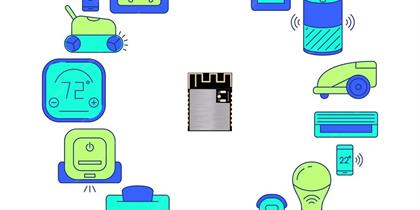
Demystifying Bluetooth Data Structures: A Deep Dive into the Core of Wireless Communication
September 15, 2024
 In the intricate world of wireless communication, Bluetooth technology has become an essential fabric of our connected lives. At the heart of this technology lies a complex yet efficient system of data structures that enable devices to communicate seamlessly. This article aims to demystify these data structures, shedding light on the core mechanisms that power Bluetooth devices.
In the intricate world of wireless communication, Bluetooth technology has become an essential fabric of our connected lives. At the heart of this technology lies a complex yet efficient system of data structures that enable devices to communicate seamlessly. This article aims to demystify these data structures, shedding light on the core mechanisms that power Bluetooth devices.
Understanding Bluetooth Data Structures
Bluetooth data structures are the foundational elements that govern how data is packaged, transmitted, and received within the Bluetooth ecosystem. These structures are designed to optimize the efficiency and reliability of wireless communication, ensuring that data is handled effectively across various devices and platforms.
The Role of Data Structures in Bluetooth Communication
Data structures play a pivotal role in Bluetooth communication, serving several key functions:
- Data Packaging: They define how data is organized and packaged for transmission, ensuring that the data is sent in a structured and recognizable format.
- Error Detection and Correction: Data structures often include mechanisms for error detection and correction, which are crucial for maintaining the integrity of the data during transmission.
- Synchronization: They facilitate synchronization between devices, ensuring that data is transmitted and received in a coordinated manner.
- Efficiency: By optimizing the way data is handled, data structures contribute to the overall efficiency of Bluetooth communication, reducing latency and improving performance.
Key Bluetooth Data Structures
Several key data structures are integral to the functioning of Bluetooth technology:
- HCI (Host Controller Interface) Commands and Events: These structures define the commands sent from the host to the controller and the events reported by the controller to the host.
- L2CAP (Logical Link Control and Adaptation Protocol) PDUs: L2CAP data structures manage the segmentation and reassembly of data packets, ensuring efficient data transfer between devices.
- GATT (Generic Attribute Profile) Services and Characteristics: GATT structures define the services and characteristics that are exposed by Bluetooth devices, allowing for the exchange of data and commands.
- SDP (Service Discovery Protocol) Records: SDP structures facilitate the discovery of services and their attributes, enabling devices to identify and connect to available services.
Applications of Bluetooth Data Structures
Bluetooth data structures are applied across a wide range of applications, including:
- Device Pairing and Bonding: Data structures ensure that devices can securely pair and bond, establishing a trusted connection for data exchange.
- Data Transfer: They enable the efficient transfer of data between devices, whether it’s for file sharing, streaming media, or real-time communication.
- Service Discovery: Data structures allow devices to discover available services and characteristics, streamlining the process of connecting to and interacting with Bluetooth devices.
- Device Management: They provide the framework for managing device connections, handling multiple connections, and ensuring that devices can be controlled and monitored effectively.
The Future of Bluetooth Data Structures
As Bluetooth technology continues to evolve, the data structures that underpin it are also expected to advance. Future developments may include:
- Enhanced Security: Data structures could incorporate more robust security features to protect against vulnerabilities and threats.
- Improved Efficiency: With the growing demand for faster data transfer, data structures may be optimized for higher throughput and reduced latency.
- Scalability: As the number of connected devices increases, data structures will need to scale to accommodate a larger number of devices and connections.
Conclusion
Bluetooth data structures are the unsung heroes of wireless communication, quietly ensuring that our devices can communicate effectively and efficiently. As we continue to rely on Bluetooth technology for various aspects of our daily lives, the importance of these data structures cannot be overstated. As technology progresses, the evolution of Bluetooth data structures will play a crucial role in shaping the future of wireless communication.
You Might Like Also

In the quest for cleaner and healthier indoor air, Bluetooth modules have become an integral part of modern air purifiers. These compact devices enable wireless communication between the air purifier and other systems, such as smartphones or home automation networks. By integrating Bluetooth technology, air purifiers can offer a range of advanced f Read More

In the modern landscape of wireless technology, Bluetooth modules have become indispensable components, enabling a myriad of applications that enhance our daily lives. These compact devices, embedded within a wide array of products, facilitate communication and connectivity with minimal effort. This article delves into the diverse applications of B Read More

The Versatility of Bluetooth Modules: Unleashing Connectivity
In the realm of wireless communication, Bluetooth modules have emerged as the Swiss Army knife of connectivity, enabling seamless interaction between devices over short distances. These compact devices have become indispensable in a variety of applications, from consumer electronics to industrial automation. Bluetooth modules are the silent workhor Read More

Enriching the Museum Experience: The Role of Bluetooth Beacons
Bluetooth Beacons are wireless transmitters that can detect the presence of mobile devices within their vicinity. In a museum setting, beacons can be placed at various exhibits to provide a wealth of information and interactive content to visitors. As a visitor approaches an exhibit, their device can receive a signal from the beacon, triggering an Read More

Bluetooth beacon used in Indoor Positioning Systems
Bluetooth beacons have become an essential component in Indoor Positioning Systems (IPS), providing accurate location data that enhances various applications within controlled environments. In smart retail settings, beacons play a crucial role in enhancing customer experiences, optimizing store operations, and driving business insights. Read More

The role of Bluetooth beacons in RTLS
Bluetooth beacons are playing an increasingly vital role in Real-Time Locating Systems (RTLS), particularly within the context of warehouse management. These tiny, yet powerful devices, are redefining the way warehouses operate, offering a new level of efficiency and precision that is transforming inventory tracking and asset management. Read More











